1964
While the basic proposals of the Technical Committee
to control wooden and plastic boats alike were approved
by the IYRU in November 1963, the most significant
contribution to the one-design credibility of the
Finn Class was accomplished by an active sailor.
Hubert Raudaschl won the 1964 Gold Cup with a homemade
wooden hull, his homemade mast, and a homemade sail.
For about 10 years wooden boats proved to be at
least equal if not superior to plastic hulls: Kuhweide
won the Gold Cup twice and later Bruder won it three
times in wooden boats. This was before the Lamboley
test was introduced, and gave the Finn Class time
to digest the shock of the early sixties after the
approval of plastic for the construction of the
hull. |
1964 also brought a change in the leadership of
the IFA. According to Heidi Auer the Secretary Vernon
Stratton lobbied successfully against the President
and managed to be elected. In accordance with Vernon
Stratton and the minutes of the AGM, Big Apple was
unable to continue, Mr. Stratton initially refused
but was finally persuaded to take the burden and
Dr. Fred Auer accepted the post of Honorary Secretary.
This was the beginning of a new eventful chapter
of the IFA, earmarked to end with an even more dramatic
coup d'etat. In that same AGM Vernon Forster was
elected to fill the newly created position of Class
Measurer as a paralysing horror for ingenious builders
and top competitors.
At the 1963 November meeting of the IYRU it had
been decided to announce a vacancy for a new singlehander.
However, soon after the 1964 Olympics it was decided
to keep the Finn as the Olympic monotype for
|
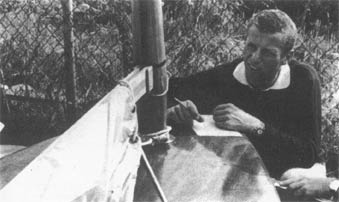 |
|
Hubert
Raudaschl
won the 1964 Gold Cup with a wooden boat
|
|
1968.
The prolific work of the Technical Committee under Richard
Creagh-Osborne had convinced the IYRU just in time that
the Finn was still the best international singlehander.
1965
The crisis was under control. Vernon Forster gave the
old boats at the Gold Cup in Poland which did not measure
in every little detail according to the new rules one
last warning. Two wooden boats from the German Democratic
Republic came first and second in the world championship
proving the one-design character of the Finn Class.
Since the Finn Class was expanding rapidly the Honorary
President and the Honorary Secretary, even with the help
of his indefatigable wife Heidi, were not able to cope
with the work load. Therefore four so called link-officers
were elected to support the executive committee. The energy
or interest of Jack Knights to produce FINNFARE had faded
away and the Auers had to do most of the work. So a new
editor was found in Belgium: Manfred Schiller. |
1966
Willy Kuhweide won the Gold Cup with à wooden Raudaschl
hull and Hubert the European Championship with guess
what type of boat. Elvstrom still had 50% of the
sail market. The Class had further expanded to 4000
sailors from 45 nations. A new rale book was issued
as the climax of Richard Creagh-Osborne Technical
Committee's endeavours. In order to create some
trouble for the sake of excitement it was suggested
to test new materials for making spars. The problems
of the years to come were casting their shadows
ahead.
The 1966 AGM acknowledged the actual power structure
of the IFA by electing Dr. Fred and Heidi Auer as
the Honorary Secretary. Vernon Stratton suggested
to limit the duration of a presidency and remained
president himself for another five years since no
one wanted the job.
|
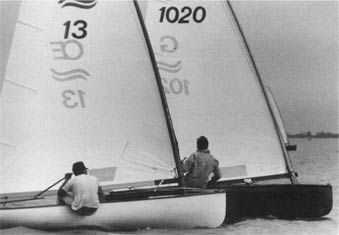 |
|
The
first suggestions for the control of the distribution
of matter in the hull were discussed already in 1966 which
would allow for the further development of the Finn Class.
In order to get hold of more financial support from eastern
European countries the Junior European Championship was
invented at the 1966 AGM.
1967
Publications about the Finn had a boom in 1967. Curd Ochwadt
wrote his 'Finn Fibel Elvstrom and Creagh-Osborne published
the 'Expert Dinghy Racing' with many references to the
Finn and the AGM decided to print an IFA Handbook 'as
soon as possible', although nothing was published until
Peter Mohilla's FINNLOG nearly twenty years later. Earlier
it was not possible. Paul Miller from the US kindly agreed
to become the Class Record Officer and to publish that
IFA Handbook. |
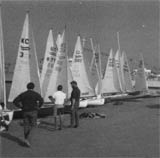 |
The 1967 Gold Cup was the climax of Chief Measurer
Vernon Forster's rale of horror. He discovered the
secret of the fast Raudaschl wooden hulls, ruling
out a hollow keel section at station 1. Even Willy
Kuhweide had to plane down the aft section of his
'Darling'. However this did not prevent him from
winning the Gold Cup for the third time.
Acknowledging the world-wide distribution of the
Finn it was agreed that the Gold Cup should be organised
outside of Europe every four years. Centre of gravity,
double bottoms, thickness of hulls, sandwich construction
and basically the control of the distribution of
matter were the burning yet unsolved problems of
the Technical Committee under Richard Creagh-Osborne
in 1967.
|
|
Dr.
Roland Langer (Austria) started to work on a new constitution
for the IFA but did not get too far. The task was taken
over by others in the years to come and was completed
in 1971. |
1968
High points of the season 1968 were the successful
Olympics in Acapulco and a disastrous Gold Cup in
Whitstable, UK. The poor organisation of that Gold
Cup caused the IFA to adopt new rules for the Gold
Cup and the European Championships.
Vernon Stratton and the Auers stayed in power with
9 link officers to support them. The Technical Committee
still chaired by Richard Creagh-Osborne was reinforced
by Gilbert Lamboley. Mr. Michael Gilchrist was elected
Editor of Finnfare unanimously never to publish
a single copy. Vernon Stratton himself continued
to do all the work. Paul Miller USA claimed to make
progress with the Class records and the IFA Year
Book but never to burst into print either.
|
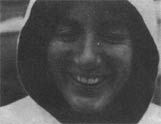 |
| Heidi
Auer, IFA secretary |
|
By 1968 Bruder and Raudaschl developed a new mast-sail
concept. They went back 15 years to stiff masts
with relatively flat sails going fast and pointing
high in light to medium winds. By making the top
of the mast very flexible sideways the leach was
freed in heavy weather, thus not overpowering a
normal size skipper. Successful tests with aluminium
and fibreglass masts and Raudaschl sails made of
different material in the top section (tracked down
and prohibited at the Gold Cup) were pointing in
the direction of future development.
|
1969
Although the rules permitted aluminium and plastic
masts in 1969 only Jack Knights brought a strange
non-wooden mast to the Gold Cup in Bermuda. The
AGM solved all the pending problems in regard with
the constitution, the rales for the Gold Cup and
the Major Championships, and the internal management
of the IFA by referring the details to the subcommittee
of the link officers. In accordance with the minutes
of the AGM all the problems were solved: in reality
hardly anything happened. The Auers suggested a
Veterans Finn World Championship for sailors over
40 years of age.
|
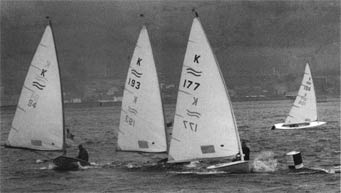 |
|
Paul
Elvstrom improved his Firm and turned up once again at
the Gold Cup to take the cup for those over 40 years of
age. By 1969 the old boom wedges were replaced by kicking
straps between mast and boom. This resulted in a change
of the sailing technique on the reaches and runs. |
1970
By 1970 the Bruder mast and Raudaschl sail combination
reached its climax. However David Hunt, with his
star pilot Patrick Pym, was working hard to make
the new aluminium Needlespar mast go fast. The big
question mark of the time was which equipment would
be used at the forthcoming 1972 Olympics in Kiel.
The 1970 AGM was very concerned about the IFA accounts
approaching bankruptcy.
Vernon Stratton was reelected president and Heidi
Auer (for the first time not together with Dr. Fred)
as secretary and treasurer. Richard Creagh-Osborne
was not able to attend the AGM and Gilbert Lamboley
was elected as the new Chairman of the Technical
Committee. Dr. Fred Auer was elected as Chairman
of the Link Officers. The proposed new constitution
was rejected by the AGM. Dr. Fred Auer was asked
to prepare a new suggestion with the help of two
lawyers.
|
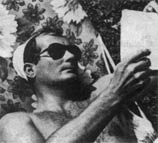 |
| Gilbert
Lamboley, Chairman of the Technical Committee 1970-1980 |
Rickard Sarby made a proposal to adopt a special
smaller 'Storm Sail' for strong winds. Since the
Contender was being considered as the monotype for
the 1976 Olympics, suggestions were made to modernise
the Finn with larger sails, longer masts, a shorter
boom, and sliding seats. However the AGM refused
all proposals to change the Finn dramatically and
the boat remained in principle as designed in 1949.
|
|